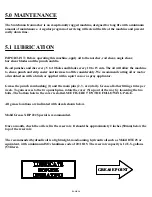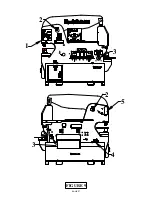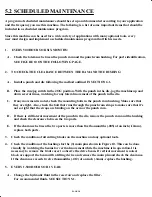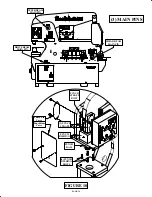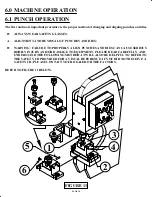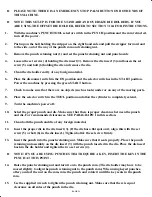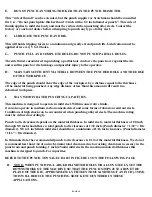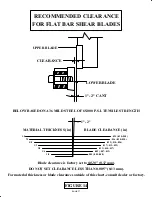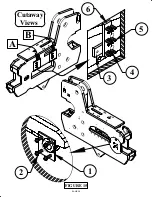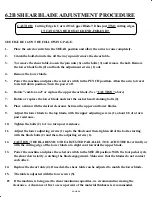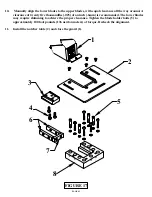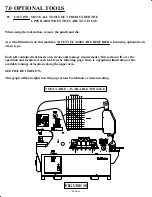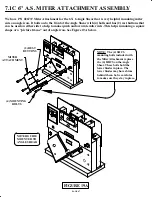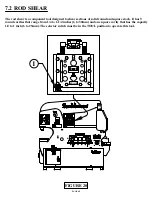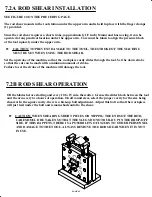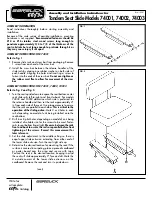
PAGE 34
E.
DO NOT PUNCH ANYTHING THICKER THAN THE PUNCH DIAMETER.
This "rule of thumb" can be extended, but the punch supplier or Scotchman should be consulted
first; i.e. "Do not punch plate thicker than 1/2 inch with a 1/2 inch diameter punch". This rule of
thumb applies to mild steel only and must be reduced when punching alloy steels. Contact the
factory or your local dealer before attempting to punch any type of alloy steel.
F.
LUBRICATE THE PUNCH AND DIE.
This will hold stripping forces to a minimum and greatly extend punch life. Lubrication must be
applied after every 5 to 10 holes.
G.
PUNCH FULL AND COMPLETE HOLES. DO NOT PUNCH PARTIAL HOLES.
The side thrust encountered in punching a partial hole can force the punch over against the die
and result in punch or die breakage and possible injury to the operator.
H.
MAINTAIN SUFFICIENT MATERIAL BETWEEN THE PUNCHED HOLE AND THE EDGE
OF THE WORKPIECE.
The edge of the punch should clear the edge of the workpiece by a distance equal to the thickness
of the material being punched. Any edge distance of less than this amount will result in a
deformed workpiece.
I.
STAY WITHIN RATED PUNCHING CAPACITIES.
This machine is designed to operate in mild steel. Within conservative limits,
it can also operate in medium carbon annealed steel and some forms of abrasion resistant steels.
Conditions of high shock can be encountered when punching alloyed steels. The machine rating
must be reduced accordingly.
Punch to die clearance depends on the material thickness. In mild steels, material thickness of 1/8 inch
through 5/8 inch should have a total punch to die clearance of 1/32 inch. (Punch di 1/32" = Die
diameter). 5/8 to 1 inch thick mild steel should have a minimum of 1/16 inch clearance. (Punch diameter
+1/16" = Die diameter).
In thin materials, the recommended punch to die clearance is 1/10 of the material thickness. We do not
recommend less than 1/64 of an inch (.4mm) total clearance due to working clearances necessary in the
punch ram and punch bushing. 1 inch (25mm) mild steel is the maximum material thickness this
machine is designed to punch. For capacities:
REFER TO THE PUNCH TONNAGE CHART IN FIGURE 13 ON THE FOLLOWING PAGE
►
NOTE: WHEN PUNCHING LARGER DIAMETER HOLES OR ALLOY STEELS, SET THE
DOWNSTROKE OF THE MACHINE SO THAT THE PUNCH STOPS JUST ABOVE THE
PLANE OF THE DIE, APPROXIMATELY FIFTEEN THOUSANDTHS OF AN INCH (.3MM).
THIS WILL REDUCE THE PUNCHING SHOCK ENCOUNTERED IN THESE
APPLICATIONS.







